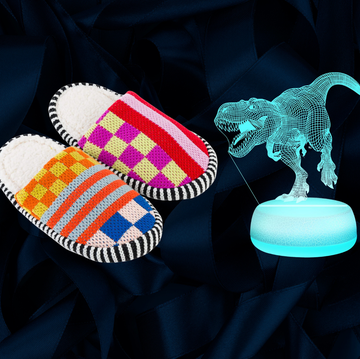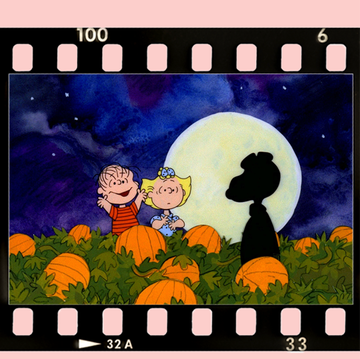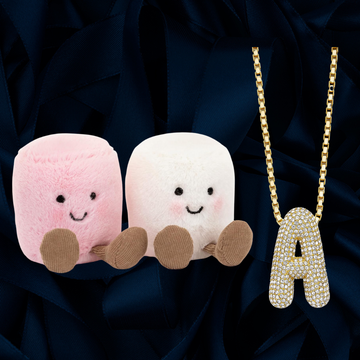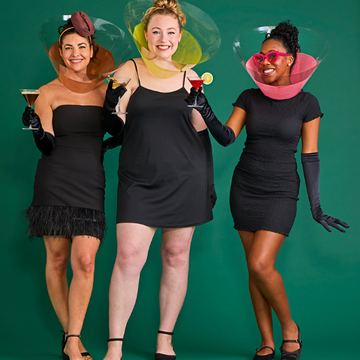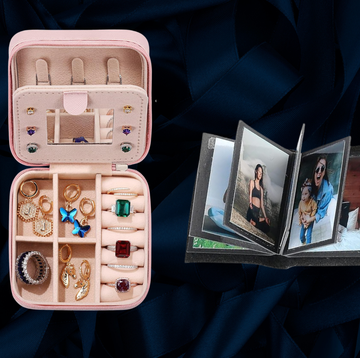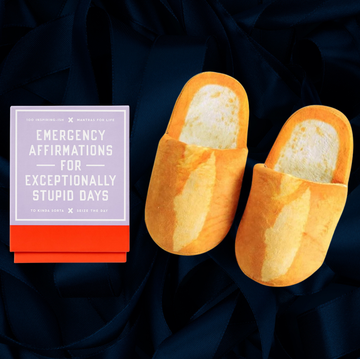If you love spooky season, you'll love this collection of Halloween fun facts. These fascinating pieces of Halloween trivia cover everything from the history of Halloween (did you know it dates back more than 2,000 years?) to horror films to Halloween candy. They're the perfect thing to break the ice at any Halloween party, or to share with your family over the dinner table. You could even use them to create your own Halloween-themed trivia game for the workplace or classroom.
There are plenty of quirky Halloween fun facts here to entertain the whole crew. For instance, can you guess how much money Americans spend on pet Halloween costumes? Or how much the world's heaviest pumpkin weighs? (Hint: It's more than 2,000 pounds!). No matter how you choose to celebrate — parties, trick-or-treating, or staying in with a Halloween movie — these Halloween fun facts are guaranteed to make any celebration better.
1. Nearly one-quarter of Americans say Halloween is their favorite holiday
Is spooky season your favorite time of year? You’re far from alone. According to a 2021 YouGov poll, 23% of Americans say Halloween is their favorite holiday. More women than men say this (26% vs. 19%).
2. A pumpkin is actually a fruit, not a vegetable
While most people might guess that those autumnal orange gourds are vegetables, pumpkins are actually considered fruit! It’s technically a fruit because anything that starts from a single flower — as a pumpkin does — is classified botanically as a “simple fruit.”
3. The record for the world’s heaviest pumpkin is over 2,000 pounds
A new record was set for the heaviest pumpkin in October 2023, when Travis Gienger presented a pumpkin weighing 2,749 pounds. As it was the year 2023, Gienger named the pumpkin “Michael Jordan” in reference to the player’s iconic jersey number (#23). He also said that the pumpkin "started out basketball round, and I said this is going to be a perfectly round basketball-shaped pumpkin.” Though it didn’t stay perfectly round, it’s still a pretty impressive pumpkin!
4. The record for most pumpkins smashed in one minute is 52
You don’t have to grow a 2,800 pound pumpkin to be a world record holder — you just have to smash a ton of pumpkins. The Guinness World Record is currently held at 52 pumpkins smashed in one minute, a feat that was accomplished separately by two different contenders in 2020.
5. 41% of Americans believe that ghosts exist
A YouGov poll conducted in 2021 found that 41% of Americans believe that ghosts exist — and 20% of Americans say they’ve had an encounter with one! About as many (43%) believe that demons really exist and 31% believe that “other supernatural beings” exist. Additionally, 9% believe that werewolves exist and 8% believe that vampires exist.
6. Most of the canned pumpkin in the world is produced by one company in Illinois
Most pumpkin recipes — like pumpkin soup, pumpkin pie, and pumpkin muffins, to name a few — are made using canned pumpkin. And almost all of that canned pumpkin comes from the Libby’s Pumpkin canning plant in Morton, Illinois. The facility produces over 85% of the world’s canned pumpkin.
7. The next time there will be a full moon on Halloween will be 2039
A full moon on Halloween is a fairly rare occurrence, happening every 18 or 19 years. The last Halloween full moon was in 2020. According to EarthSky, we can expect the next Halloween full moon to happen on October 31, 2039. In 2025, the moon on Halloween will be a waxing gibbous, approximately 70% illuminated.
8. Mamie Eisenhower was the first person to decorate the White House for Halloween
In 1958, First Lady Mamie Eisenhower decorated the White House for Halloween for the first time with skeletons hanging from the wall lights, yellow jack-o'-lanterns, dried corn, black cats, and goblins, among other decor. Many of the White House’s other occupants have continued the tradition of decorating the home for Halloween.
9. Americans spend a ton of money on Halloween costumes for their pets
We love Halloween costumes for pets, and apparently we’re not alone! According to the National Retail Federation, Americans spent about $700 million on pet costumes in 2024.
10. Most parents admit to stealing some of their children’s Halloween candy
According to a 2019 YouGov poll, 74% of parents with children younger than 18 confess that they usually eat at least a few pieces of their children’s Halloween candy. If you’re among them, we promise, your secret is safe with us!
11. If you want to keep spooky spirits away, salt should do the trick
If you've watched any supernatural shows, you might notice that some characters use salt as a way to protect themselves against frightening spirits — and there's a pretty good reason why. Some say that salt acts as a "protective shield against evil spirits and malevolent entities" and has been a practice dating back to ancient times. Even if you're not a true believer, it can't hurt to sprinkle a bit on your doorstep should any unwelcome visitors stop by on Halloween night.
12. Jason Vorhees from Friday the 13th really did drown in the lake ... kind of
The villainous serial killer from the infamous Friday the 13th franchise remains at the bottom of a Minnesota lake in statue form. Diver Doug Klein constructed a Jason Vorhees statue, mask and all, made of plywood, bubble wrap and foam and had it placed 120 feet down in a water-filled mine pit known as Louise near Crosby, Minnesota. It's only able to be seen by the most advanced divers.
13. There's a city in South Carolina that renamed itself "Halloween"
According to The State, a newspaper published in Columbia, South Carolina, back in 2022 a city in Horry County called Conway announced that for the month of October they would be renamed the "city of Halloween," in an effort to "boost tourism and economic development during the fall season." Since 2022, they have continued to do so every October, with each yearly celebration getting more and more festive by increasing the seasonal events, decor and activities all month long.
14. One in five adults usually pretend not to be home on Halloween
A 2021 YouGov poll found that about one in five adults (or 21% of participants) keep the porch lights off and pretend not to be home when the trick-or-treaters come knocking — a number that radio station WBIW alleges has increased since, with the number more accurately being reported as 25% percent in 2023.
15. "Trick or treat" was not necessarily the original phrase children would shout out to receive candy
Instead, kids would allegedly yell, "Belsnickel!". According to the Library of Congress, historians argue that the modern call originated from "belsnickeling," a German-American Christmas tradition where kids dressed in costumes and went around to their neighbors to see if they could guess the identity of those dressed up. In some versions, if the adults couldn't accurately guess, the children were rewarded with treats and goodies.
16. There's a reason black and orange are the colors most associated with Halloween
The Library of Congress reports that the colors of black and orange trace back to the Celtic festival of Samhain, a Gaelic festival marking the end of the harvest season and beginning of winter — or the "darker half" of the year. Thus, black represents the "death" of summer while orange represents the life of the fall harvest.
17. Some pretty famous people were born on Halloween.
According to Famous Birthdays, plenty of celebs were born on Halloween. Piper Perabo, Willow Smith, Rob Schneider, Letitia Wright, and Vanilla Ice were all born on October 31.
18. The holiday dates back more than 2,000 years
Halloween is even older than Christianity itself. It all started as a pre-Christian Celtic festival called Samhain, which means "summer's end." Held in the beginning of November, the feast recognized the last day of the fall harvest and spirits crossing over, since they believed the veil between the living and spirit world grew thinnest at that time. People in Ireland, the United Kingdom and Northern France used to ward off ghosts by lighting sacrificial bonfires, and – you guessed it – wearing costumes to trick the spirits, according to History.com.
19. Trick-or-treating has existed since medieval times
Taking candy from strangers one night a year (and one night only!) isn't a new or uniquely American tradition. It once was known as "guising" in Scotland and Ireland. Young people dressed up in costumes and went door-to-door looking for food or money in exchange for performing songs, poems or other "tricks." Today, the tradition has morphed into children getting dressed up and asking for candy. Hardly anyone sings for their mini Snickers these days — but a simple "thank you" will go a long way.
20. Some Halloween rituals used to be geared toward finding a husband
During the 18th century, single ladies devised Halloween traditions that were supposed to help them meet their romantic match. According to History.com, women used to throw apple peels over a shoulder, hoping to see their future husband’s initials in the pattern they made when they landed. When bobbing for apples at parties, the winner would supposedly marry first. Most spookily, they even used to stand in a dark room, holding a candle in front of a mirror to look for their future husband’s face to appear in the glass. Bloody Mary who?
21. Immigrants helped popularize the holiday in the U.S.
When the Irish fled the potato famine that devastated their country in the 1840s, they brought their Halloween traditions with them. The celebration spread across the country until the mischievous Halloween pranksters reached an all-time high in the 1920s. Some believe community-based trick-or-treating became popular in the 1930s as a way to control the many pranksters.
22. Sugar rationing during World War II paused trick-or-treating
Because of the shortage of the sweet stuff, trick-or-treating wasn't as big of a thing during WWII. After the rationing ended, it was all systems go on the candy-collecting front. Candy companies began launching advertising campaigns to cash in on the ritual and make sure kids were clamoring for their products to show up in their candy buckets and spare pillowcases.
23. Now Halloween is the second-largest commercial holiday in the country
Only Christmas rakes in more dough. According to the National Retail Federation, it's alleged that consumers spent a record $12.2 billion, exceeding the record-breaking $10.6 billion recorded in 2022. It's also reported that a record 73% of people participated in Halloween activities, up from 69% in 2022.
24. Most Americans spend on candy, decorations and costumes
Many of us put our money where our mouth is when it comes to loving Halloween. According to the National Retail Federation, broken down, it's estimated on average that people spent $108 per person on candy, decorations and costumes, with numbers reaching overall $4.1 billion on costumes, $3.6 billion on candy, $3.9 billion on decorations and half a billion on greeting cards alone. Overall, Americans spent an average of $1,048 on winter holidays in 2019, if you're wondering why we all tighten our belts in January.
25. The Irish also brought us jack-o'-lanterns
As the story goes, an Irish man named Stingy Jack tricked the devil and therefore was not allowed into heaven or hell — so he spent his days roaming the Earth carrying a lantern; hence the name "Jack of the Lantern." Tell that story to the kids when you pick up your seasonal squash and try not to get goosebumps when you carve up your own pumpkins this year.
26. They used to be carved out of turnips, potatoes and beets
Jack-'o-lanterns did originate in Ireland, after all. Once Halloween became popular in America, people used local produce like pumpkins instead. This year, you might consider adding some creative carvings to your Halloween tableau for a more natural look that also has historical origins. When the holiday's over, they make a delicious dinner side dish!
27. There's also traditional Halloween bread in Ireland
It's called barmbrack or just "brack." The sweet loaf typically contains dark and golden raisins, as well as a small hidden toy or ring. Similar to the classic king cake at Mardi Gras, tradition dictates that the person who finds the item will come into good fortune in the coming year. That is, as long as they don't choke on the trinket.
28. Disney almost made Hocus Pocus a completely different movie
Everyone's Halloween fav was almost a freakier flick. The original title, Disney's Halloween House, had a much darker and scarier script, according to IMDB. Not only that, but Leonardo DiCaprio was courted to play teenage heartthrob Max Dennison but turned it down to appear in What's Eating Gilbert Grape instead.
29. Illinois produces more than twice as many pumpkins than any other state
If you're in the market for a truly destination-worthy pumpkin patch, head to the heartland. The Land of Lincoln has more than 17,6000 acres devoted to gourd growing, according to the United States Department of Agriculture. Those Illinois farms typically grow about 37,500 pumpkin pounds per acre and about 630 million pounds of pumpkins overall in 2022, a number that has surely increased within the last two years.
30. Candy corn was originally called "chicken feed"
The Goelitz Confectionery Company originally sold the polarizing treat in boxes with a rooster on the front to appeal to America's agricultural roots, according to National Geographic. The sugary recipe has gone largely unchanged since the 1880s. Love 'em or hate 'em, you can't argue with that kind of consistency.
31. "Monster Mash" once reigned supreme on the Billboard charts
Bobby "Boris" Pickett reached #1 on the Hot 100 in 1962 just before Halloween and hit the charts again in 1973 — but this time in August. More recently, in 2021, it re-entered the Billboard Hot 100 chart at number 37. You might even say it continues to be "a graveyard smash!"
32. You can even visit a pumpkin patch in Hawaii
Head to Waimanalo Country Farms in Oahu to pick pumpkins while you're on the islands, whether you live there or need a taste of home on vacation. Looking for squash in Florida? Try the Pickin’ Patch in Dunnellon. It's a watermelon farm the rest of the year but pivots to pumpkins to cash in on the seasonal appeal.
33. The Michael Myers mask in Halloween has a fascinating backstory
The famous horror movie villain comes from surprisingly innocent roots. When shooting the original 1978 film, production designer Tommy Lee Wallace picked up two masks from a Hollywood Boulevard magic shop: a clown mask and William Shatner as Captain Kirk in Star Trek.
"Tommy came in with the clown mask on, and we went, 'Ooh, that’s kind of scary.' Then he put on the Shatner mask, and we stopped dead and said, 'It’s perfect,'" actor Nick Castle told the New York Times. They spray-painted it white, made the eye holes bigger and the rest is spine-tingling history.
34. The fastest pumpkin carving ever only took 16.47 seconds
Stephen Clarke of New York holds the Guinness Book of World Records distinction, having speedily carved his lantern in October 2013. In order to nab the title, the jack-o'-lantern had to contain a complete face, including eyes, nose, mouth and ears. No word on whether the expression was silly or scary.
35. New York City throws the biggest Halloween parade in the U.S.
On an average year, the event draws more than 2 million spectators and includes about 70,000 participants joining in as the route winds through Greenwich Village. It all began as the brainchild of Greenwich Village resident and puppeteer Ralph Lee, who just wanted to have a whimsical walk from house to house for his kids and their pals. When a local theatre got wind of it, they joined in and expanded the event. It's gotten bigger, more creative and more theatrical just about every year since.
36. Princesses and superheroes rank as the most popular costumes
Barbie was one of the most popular costumes for adults in 2023, following the success of the Barbie movie which premiered in July 2023, but princesses and superheroes still continue to be top choices, followed by witches, fairies and dinosaurs according to Google Trends.
37. Reese's Cups are the top Halloween candy
There must be something about that blend of chocolate and peanut butter that can't keep people away since Reese's Cups are the most popular Halloween candy, with M&M's and Hot Tamales, Skittles and Sour Patch Kids following in order to round out the top five favorites, according to CandyStore.com and Navigator Research.
And although the ever-iconic candy corn ranked among the worst Halloween candies in the past, according to a CandyStore.com survey, it made its return to the top ten for favorite Halloween candy at number eight. No wonder Halloween night candy trades can get so intense.
38. A city in Canada banned teens over 16 from trick-or-treating
According to CBC, anyone over the age of 16 caught trick-or-treating in Bathurst, Canada, faces up to a $200 fine. The city also has a curfew for all residents, so even those under 16 aren't allowed out after 8 p.m. on Halloween. The rules were instituted to curtail after-dark mischief, after a rash of pranks.
39. Harry Houdini died on Halloween in 1926
The famous magician, illusionist and entertainer died from peritonitis caused by a ruptured appendix, according to Biography.com. However, as befits a man of mystery, multiple contradicting reports did surface at the time. Some say a band of angry Spiritualists poisoned him, others that it was a student punching him in the stomach (with his permission) that caused his appendix to burst.
40. Some shelters used to suspend black cat adoptions for Halloween
They feared that the animals were in danger from Satanic cults that wanted them for nefarious purposes in the days leading up to Halloween. Now though, shelters have gone in the opposite direction. Many even promote black cat adoptions in October, using the pre-adoption screening and interview process to weed out anyone with less-than-snuggly intentions.
41. Keene, New Hampshire, holds the record for the most jack-o’-lanterns on display
In October 2013, the city broke the record with 30,581 lit pumpkins displayed around town. Talk about lighting up the night!
42. The night before Halloween is called Mischief Night or Goosey Night
For those who've lived on the East Coast and the Midwest, it's probably not news to you that lots of teens and tweens pull pranks on October 30. But from toilet papering the trees outside someone's house, to egging cars and more dangerous capers, the tradition never really made its way to the West Coast. At least, not yet.

Lauren is a senior editor at Hearst. She was previously the senior editor at WomansDay.com and the home editor at GoodHousekeeping.com and HouseBeautiful.com. Her book club, ramen, and jean jackets are a few of her favorite things.

Caroline is a writer and editor with almost a decade of experience. From 2015 to 2019, she held various editorial positions at Good Housekeeping, including as health editor, covering nutrition, fitness, wellness, and other lifestyle news. She's a graduate of the Medill School of Journalism and dreams of the day Northwestern will go back to the Rose Bowl.

Jamie Ballard (she/her) is a freelance writer and editor who covers news, lifestyle, and entertainment topics, including sex and relationships, TV, movies, books, health, pets, food and drinks, pop culture, shopping, and personal finance. She regularly contributes to Cosmopolitan, Woman’s Day, Good Housekeeping, and YouGov, among other publications. When she’s not working, you can find her running, traveling, or scrolling TikTok. Follow her on Twitter.








